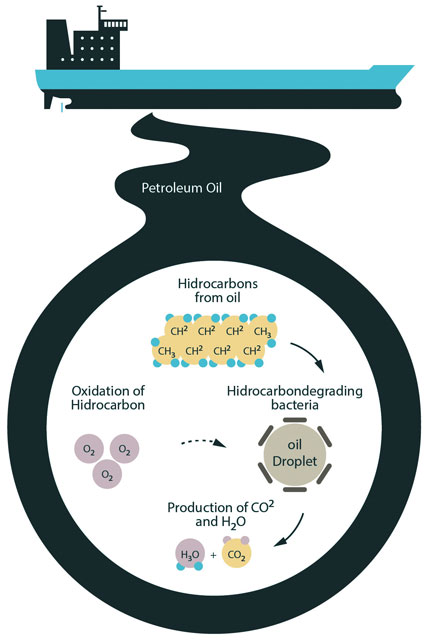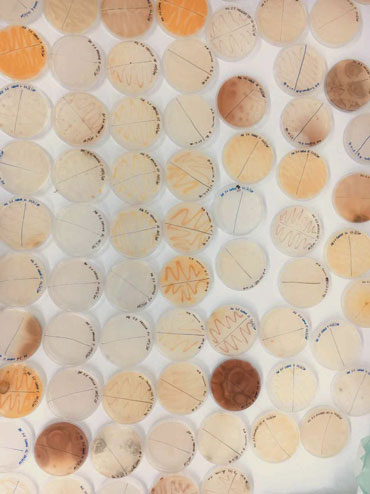(1)CIIMAR - Interdisciplinary Centre of Marine and Environmental Research, University of Porto, Portugal.
(2)INESC TEC
Marine oil spills are catastrophic events that lead to high losses of marine life and ecosystems. Oil spill incidents occur regularly during the exploration, production, refining, transport and storage of petroleum and petroleum products. In recent years, several oil spill disasters have occurred, with Deepwater Horizon (2010) being considered one of the largest accidental marine oil spill in the history of the petroleum industry, leading to the spill of over 500.000 tons of crude oil, at the Gulf of México. In the last 50 years, several major spills occurred in the NW Iberian Peninsula, one of the main routes of oil cargo in Europe, because of tanker accidents. In 1975, the oil tanker Jakob Maersk, which was loaded with 80.000 tons of heavy crude oil and 4.000 tons of heavy fuel, hit a sandbank while entering the sea harbour of Leixões (Porto, North of Portugal) and ended up exploding and breaking apart. As a result, around 50.000 tons of oil were consumed by fire, 25.000 tons were drifted at sea and 15.000 tons came to shore. More recently, in 2002, the oil tanker Prestige sank 250 km from the coast of Galicia (North of Spain) spilling more than 60.000 tons of crude oil, polluting thousands of kilometres of coastline and causing great harm to the local fishing industry. This was considered one of the larger environmental disasters in the history of Iberian Peninsula. Jakob Maersk and Prestige cases occupy the 13th and 20th position, respectively, at the ranking of the worldwide major oil spills (ITOF 2015).
The occurrence of such incidents requires immediate, simple, effective, and eco-friendly actions to minimise environmental damages. First-line responses typically include physical (e.g., controlled burning; absorbing) and chemical (e.g., dispersing) removal of oil, which is largely constrained by maritime conditions. Though these treatments are important to rapidly control the diffusion and drift of the oil, they are not suitable for ecological restoration. Recently, bioremediation using microorganisms to degrade the remaining spilled oil, has been proposed as a cost-effective alternative to the use of chemical additives. The use of microorganisms with a natural capacity to degrade petroleum is highly advantageous, since it is an environmentally friendly process and allows complete decomposition of complex petroleum hydrocarbons (Fig. 1). The efficient biodegradation of oil spills requires a jointed action of a consortium of microorganisms, i.e., a group of diverse microbial species with a complementary range of metabolic capabilities, rather than the action of individual microbial species.

Figure 1: General process of petroleum hydrocarbons biodegradation
The success of bioremediation to improve petroleum removal and reduce clean up time and costs, relies on two major approaches: (i) addition of nutrients to stimulate the growth of the microorganisms that break down oil (Biostimulation) and (ii) the addition of pre-grown microbial cultures/consortia to enhance microbial populations (Bioaugmentation). The use of native microorganisms is highly beneficial because they are better adapted to the affected environment, leading to a more efficient degradation of complex hydrocarbons. Plus, this technique avoids the unpredictable ecological impact of introducing non-native organisms into a particular environment.
The natural cooperative partnership in microorganisms is a key element that must be considered when planning to develop bioaugmentation strategies to degrade highly diverse and complex compounds e.g., oil and petroleum products. The efficiency of this strategy has already been demonstrated for crude oil in beach sediments - in microcosm [1] and mesocosm [3] experiments - by CIIMAR researchers, within the scope of the project OILDEBEACH (Buried oil in the intertidal beach zone: coupling between beach morphodynamic, natural degradation, forcing mechanisms and biological activity), this is an FP6 project implemented to address the Prestige oil spill. Recently, within the projects Spilless (First line response to oil spills based on native microorganisms cooperation), ROSM (Robotic Oil Spill Mitigation) and BIOREM (Bioremediation of hydrocarbon pollutants by autochthonous microorganisms in aquatic environment), the researchers from CIIMAR and INESC TEC developed innovative approaches to oil spills mitigation, based on the production of native microbial consortia with bioremediation capacity, and the adaptation of unmanned and autonomous vehicles for in-situ release of autochthonous microorganisms (bioaugmentation) and nutrients (biostimulation). Such innovative solutions aim to:
be environment-friendly, by using native organisms to naturally degrade oil spills, and avoid the introduction of additional chemical or biological additives;
integrate first line responses to oil spill incidents, by using unmanned and autonomous vehicles, which are able to operate under unfavourable and harsh conditions with low human intervention;
set-up holistic pollution combat missions, by jointly combining air, surface and underwater vehicles;
increase the overall efficiency of the oil spill combat missions, by acting on defined targets and areas;
this increasingly distant relation tends to increase given the targets included in the National Energy and Climate Plan 2020 – 2030. According to this plan, the wind capacity is planned to increase from 5 400 to about 9 000 MW; the solar photovoltaic capacity from 1 400 to about 9 000 MW; and the hydro capacity from 7 200 to about 9 000 MW. This evolution will determine, for instance, that in periods with large wind and hydro generation or with large solar photovoltaic generation, the market prices will be reduced or even reach zero in many hours;
provide valuable data, by equipping the vehicles with sensors, which can perform environmental monitoring (before, during and after oil spill combat missions);
decrease the overall time to reaction and mission costs, by using unmanned and autonomous vehicles, whose deployment is faster and less costly than using boats, planes, or helicopters.

Figure 2: Workflow for the development of georeferenced library of native microbial consortia for bioremediation of oil spills
The scientific strategy of these projects included a new concept of georeferenced library of native microbial consortia (Fig. 2), with capacity to degrade petroleum compounds, which could be applied by autonomous vehicles (aerial, surface and underwater) at specific geographic areas. More than 800 hydrocarbon-degrading bacteria were isolated from the NW Iberian Peninsula coast [3], for future use in bioremediation of oil spills in specific geographic areas. These bacteria are cryopreserved in a georeferenced library that is part of the CIIMAR Microbial Culture Collection (CM2C) (Fig.3). Some of said bacteria were already used to optimise the conditions for biomass production, leading to the formulation of a lyophilised microbial product [4] for application in oil spill scenarios. In addition, containers and autonomous release systems [5] were developed for application of bioremediation treatments by aerial, surface and underwater vehicles (Fig. 4). This includes mechanisms to release bacteria and nutrients from three distinct ways: (i) from an unmanned aerial vehicle (UAV), and for rotary wing with high positioning accuracy, to tackle leakages from the surface "inner" areas; (ii) from an autonomous surface vehicle (ASV) to release microbial consortia on the stroke border areas; (iii) from an autonomous underwater vehicle (AUV) / remotely operated vehicle (ROV) to release microbial consortia in the water column and the seabed. Finally, all the vehicles were tested for their operability under different environmental conditions [6].

Figure 3 - Hydrocarbon-degrading bacteria isolated from the NW Iberian Peninsula coast and preserved at CIIMAR Microbial Culture Collection (CM2C).
References
[1] UN Environment Programme. (2018). Marine Litter and Microplastics: Global lessons and research to inspire action and guide policy change. Retrieved from https://wedocs.unep.org/bitstream/handle/20.500.11822/25496/singleUsePlastic_sustainability.pdf
[2] Pontes J., Mucha A.P., Santos H., Reis I., Bordalo A., Basto M.C., Bernabeu A., Almeida C.M.R. 2013. Potential of bioremediation for buried oil removal in beaches after an oil spill. Marine Pollution Bulletin, 76: 258–265 (https://doi.org/10.1016/j.marpolbul.2013.08.029).
[3] Bôto ML, Magalhães C, Perdigão R, Alexandrino DAM, Fernandes JP, Bernabeu AM, Ramos S, Carvalho MF, Semedo M, LaRoche J, Almeida CMR, Mucha AP. 2021. Harnessing the Potential of Native Microbial Communities for Bioremediation of Oil Spills in the Iberian Peninsula NW Coast. Frontiers in Microbiology 12:879. https://doi.org/10.3389/fmicb.2021.633659
[4] Perdigão R, Almeida CMR, Magalhães C, Ramos S, Carolas AL, Ferreira BS, Carvalho MF, Mucha AP. 2021. Bioremediation of Petroleum Hydrocarbons in Seawater: Prospects of Using Lyophilized Native Hydrocarbon-Degrading Bacteria. Microorganisms 9 11:2285. https://doi.org/10.3390/microorganisms9112285
[5] Dias, A., A. P. Mucha, T. Santos, D. Pedrosa, G. Amaral, H. Ferreira, A. Oliveira, A. Martins, J. Almeida, C. M. Almeida, S. Ramos, C. Magalhães, M. F. Carvalho, and E. Silva. 2019 “ROSM - Robotic Oil Spill Mitigations”. In: OCEANS 2019 – Marseille, pp. 1–7. https://doi.org/10.1109/OCEANSE.2019.8867213
[6] Bernabeu AM, Plaza-Morlote M, Rey D, Almeida M, Dias A, Mucha AP 2021 Improving the preparedness against an oil spill: evaluation of the influence of environmental parameters on the operability of unmanned vehicles. Marine Pollution Bulletin 172: 112791. https://doi.org/10.1016/j.marpolbul.2021.112791